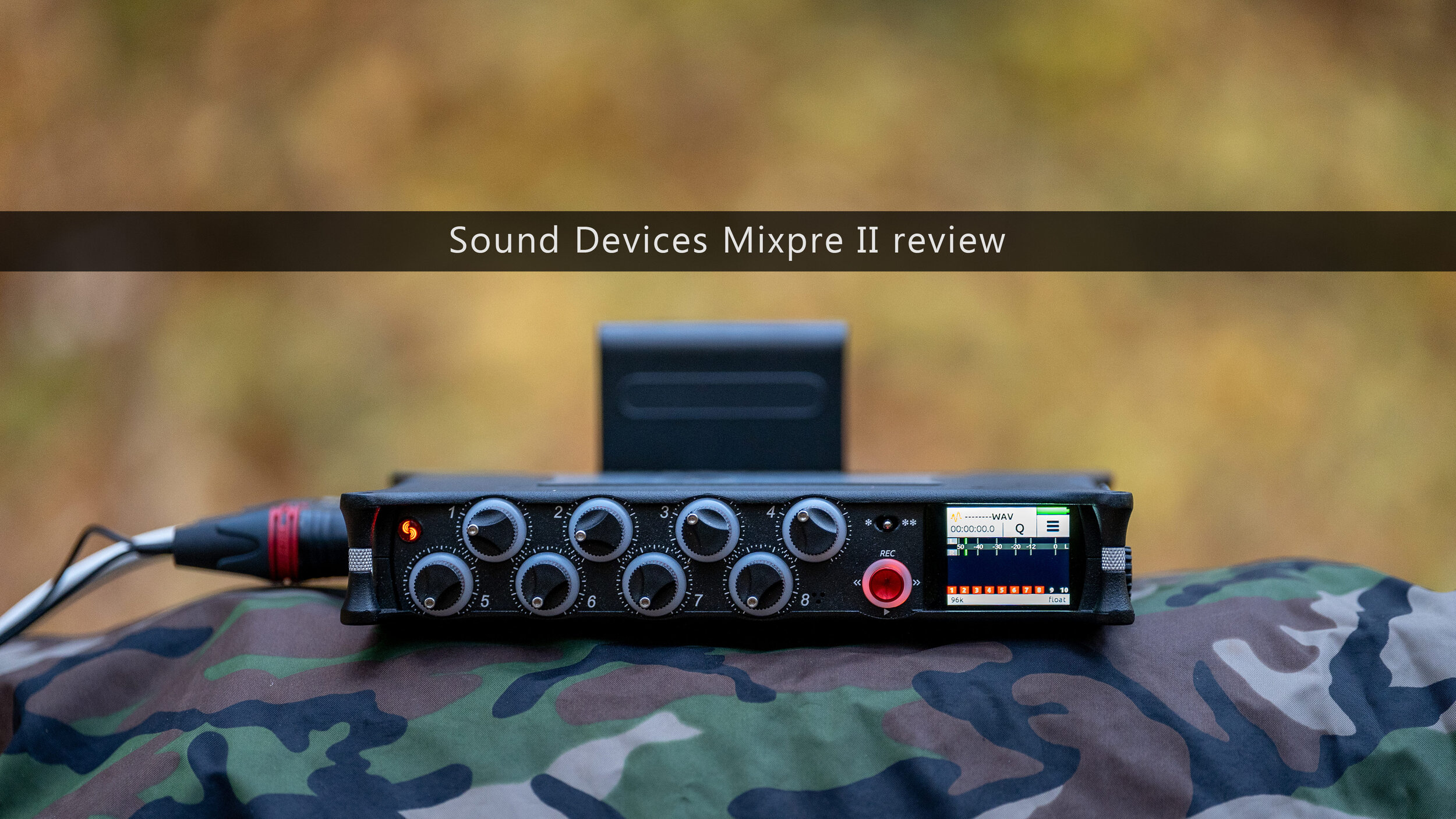About 3 years ago Sound Devices released the 1st generation Mixpre recorders and I was among the first UK buyers to get the Mixpre 6. Sadly it didn’t really stand up to the hype because of issues like ultrasonic preamp noise, weird limiter release time, firmware bugs and mediocre ergonomics. As soon as I got my 1st gen Mixpre 6 I spoke to several people at Sound Devices, as did other fellow sound recordists. Encouragingly, many issues we brought up were fixed in subsequent firmware updates. It wasn’t all bad though. There were good aspects too and I included everything in the review I wrote for the Audio Spotlight.
“Of course, the opinions I express in this review may differ from your own. I welcome civilized debate so feel free to post your thoughts in the comments section below. I have made the two recordings in this article downloadable thorugh Soundcloud so anyone can have a closer look at uncompressed 24/96 versions.”
Does the Mixpre pass the fire ant test? Watch the video to find out.
Fast forward to late 2019 and Sound Devices released the second generation Mixpre devices. This time I was the first European recipient of a Mixpre unit (10 II to be more precise). Sound Devices sent me the unit for testing but did not offer any freebies and did not pay me to write this review. After sending the Mixpre 10 II back I decided to purchase a Mixpre 6 II with my own money and I’m using this along the old 10T, a 633 and a Zoom F6 (review coming soon).
Disclaimer out of the way, I need to mention that my main use for these devices is field recording for media and to a lesser extent for conservation and music composition. I often travel to pretty remote places and the kit I use needs to withstand extreme heat, frost, humidity, dust, smoke and sometimes even acid. I’m not afraid to jump into lakes or to hang precariously over the edge of a volcano if that will get me a good recording. Consequently my gear is put through serious tests every time I’m on an expedition.
My main recorder has been the Sound Devices 633 ever since I picked it up in 2014. I also use handhelds like the Sony PCM D100, D10 and A10 in drop rigs. The 633 is rock-solid and performs brilliantly, but it’s quite heavy and costs 5 times as much as the smallest Mixpre. The handhelds are very portable and great for use with small PIP mics but don’t offer phantom power and it’s difficult to record surround with them (although not impossible).
The Good
On my recent trip to Borneo I had to make a choice. I could either take one 633 recorder or two smaller ones (Mixpre 6 II and zoom F6). Given that there was going to be a lot of hiking involved, I ended up choosing the two recorders and left my 633 home. In situations like these, lighter is better and redundancy is key. I was also planning on recording quad ambiences and the 633 is limited to 3 channels which didn’t quite work for this task.
Recording Borneo soundscapes with Sound Devices Mixpre 6 II
The Mixpre 6 II performed without a hitch and allowed me to make beautiful recordings. Its Kashmir preamps worked brilliantly when coupled with my Sennheiser MKH8040 and MKH30 mics. I’ve also used the Mixpre (this time the 10 II) on a few vehicle recording sessions and the results were great. Strictly in terms of sound quality, the Mixpre II recorders are on par with the Sound Devices 633, a device that costs many times more.
The small form factor and light weight compared to the number of preamps it offers are another excellent aspect. I’m often in situations where I have to hike with my gear over long distances and even if I train a lot for this, it’s always better to have less weight in my backpack. That goes for suitcases and air travel too.
Recording old cars with the Mixpre 10 II
One thing I haven’t mentioned so far is 32 bit float recording. Check out this article for more info about it, but in a nutshell this feature allows the device to record information above the level at which 24 bit files would normally clip. Coupled with the multiple analog to digital conversion system, 32 bit recording makes it possible to sidestep compressors and to always get clean recordings without clipping regardless of loudness.
Speaking of limiters, Sound Devices have listened to my (and other recordists’) complaints and offered controls for things like limiter threshold, ratio or release time. They still don’t sound as good as the ones on the 633 but it’s a step in the right direction.
Sound Devices Mixpre 6 II in the mud
Powering options are quite varied. Mixpres take AA batteries but this isn’t a sustainable option for my style of recording. I love to power my small recorders via USB-C since I always have a bunch of powerbanks with me. These are easy to recharge and don’t require a bulky charger like big camera batteries like NP1 or NPF ones. You can still use NPF batteries but you’ll need to purchase a separate mount for these, and they will stick out at a weird angle (see the photo below).
Other useful features are 192kHz recording option on all Mixpre II devices, internal timecode generator and auto copy to USB feature. This last one is interesting and may mitigate SD card issues to some extent but I’d still prefer dual memory recording.
A very important consideration when buying equipment is customer support and overall responsiveness. I was surprised to see how fast Sound Devices fixed issues by releasing firmware updates (not the ultrasonic noise one, that one took over a year). Company reps are active on Facebook groups and email communication is quite fast, which is not something I can say about Zoom. In the few interactions I’ve had with Zoom, they were slow to reply (or didn’t reply at all) and quite opaque to suggestions.
The Bad
Sound Devices Mixpre 10 II in the field
Sadly the ergonomics on the 2nd gen Mixpre are the same as on the 1st generation since they haven’t changed the exterior of the units. The power button is still in a very awkward position right next to the power cable. The Hirose input on the 10 II is very weirdly positioned to one side of the bottom of the unit. The fact that XLR inputs are present on both sides of the units makes it more difficult to operate them in certain bags. It is also quite annoying that I have to purchase an external mount if I want to use NP-F batteries.
Sound Devices announced that 64GB and 128Gb 170MB/s Sandisk SD cards are not compatible with Mixpre II devices because of handshake protocols or similar technical issues. This is certainly weird and regardless how much sense it makes, other manufacturers have never made such excuses. I’ve been using only Sandisk memory cards for many years and I have more than a few dozen. Should I just replace them all because Sound Devices failed to work this out before releasing their firmware? (That said, I was in Borneo when I found out about this and had no way to replace my memory cards so I kept using them. Everything worked fine and I had no problem recording or copying content over to my computer.)
Comparison with other devices
Mixpre 10t and Zoom F6 hanging out
The Zoom F6 also does 32 bit recording (although slightly differently) and offers a good channel count for even cheaper than the cost of a Mixpre 3 II. I’ve had mine for several months and I’ve used it on several expeditions so far. If I had to choose between the F6 and the Mixpre 6 II I’d probably go with the Sound Devices, unless I needed more than 4 channels.
In my comparisons, the Mixpres are slightly less noisy but not by much. One thing that determined me to favor the Sound Devices recorders is the powering solutions. On the Mixpres, you can plug in an NP-F battery and a powerbank and the recorder will automatically switch between the two when one source is depleted. On the F6 you have to select power source priority in the menu and if you get it wrong the unit will switch off even with a fully charged battery plugged in. I learned this the hard way in Borneo and when I suggested to Customer Support that this should be improved they didn’t even bother to reply.
Conclusion
Jungle surround recording with the Mixpre 6 II
Of course, there’s no such thing as THE best recorder. Every piece of kit comes with advantages, disadvantages and compromises. Mixpres are small and light for the channel count they offer, their preamps are excellent and they’re quite affordable. They’re perfect for non-critical projects where what’s being recorded can be replicated in case something goes bad.
This was my reasoning when I took my 6 II to Borneo as I spent more than a few days recording the same location so I could always go back and record more if something went wrong. On my trip to Ethiopia however I chose the 633 since I only had one chance to record the volcano. I would have been very disappointed if I had a card fail on me in this situation.
Of course, there’s always room for improvement. Sound Devices should sort out the SD card debacle fast. Luckily it seems like they listen to customer feedback and they’re probably working on a fix. I’ll keep using my 6 II, my old 10T and my 633 along my F6 and smaller handhelds depending on what’s needed for the shoots I go on. Feel free to ask questions if there’s something I haven’t mentioned or covered and I’ll get back to you.
Get these recorders on Amazon at:
Mixpre 3 ii: https://amzn.to/2MTp1vS
Mixpre 6 ii: https://amzn.to/2MP2Tmh
Mixpre 10 ii: https://amzn.to/2UE36gb
Have you found this review useful? You can support me by doing one or more of the following:
buy me a coffee and you’ll get a bunch of free recordings
support me on Patreon and you’ll get even more goodies
buy my sound effects libraries, they’re awesome!
lastly, share, comment and support me on social media

